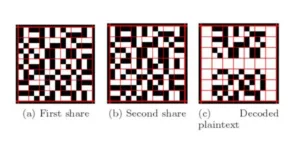The University of North Carolina (UNC) at Chapel Hill presented a new method of cryptography based on augmented reality. The system is based on visual cryptography and uses two independent displays that combine into a single image to provide the message.
The system is a form of “one time pads” that have been used for a long time as a very secure method of encryption and one that may be insolvable if the cipher key is absolutely random. This maybe a small caveat, but on the other hand this is not a trivial task to solve either. Nevertheless, one time pads were used during the Cold War as a method that made cracking the message impossible without the key provided on a separate pad. Since this key was used only once, the name “one time pad” was used for this encryption method.
UNC is now combining this idea with visual cryptography, where the message is encoded in a pixel structure instead of clear text. In this approach, the text consists of a random distribution of pixels that contain two black and two white subpixels, creating a gray background shown on the message display. The cipher key has the same pixel and subpixel structure, but in the message areas the black subpixels fall on white subpixels, creating a black message for the user. This image is shown on the AR glasses. Both working together creates a readable message as shown in the following image, even though the deciphered text is shown as white text rather than black.
Source: University of North Carolina
As an important factor for the use of this system, neither display (AR glass or message display) contains the actual message and hacking either device will not help any third party to retrieve the information.
On the practical side, the message could include a note on what cipher key to use, making this system rather easy to use. The accuracy of this system relies on a correct alignment of the message (first share) and the key (second share) to create a visual image for the user. This may cause some issues with involuntary head movements for some users. In the test setup, UNC was using a contraption remotely reminding one of a James Bond or similar movie.
 Source: University of North Carolina
Source: University of North Carolina
The image shows that the head was stabilized to allow for testing the deciphering capabilities of the system. First results were very encouraging, with a high percentage of test subjects being able to decipher a text and observe other variances. The results varied somewhat, depending on which AR glasses were used. They tried most of the commercially available headsets and saw that the binocular Epson Moveria headset gave better results than Google Glass.
Overall they are seeing image stabilization, resolution and field of view as important areas for further improvements before such a system may be used in the field of encryption. – NH

